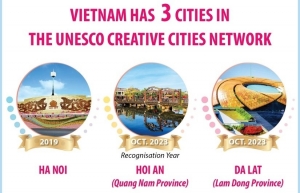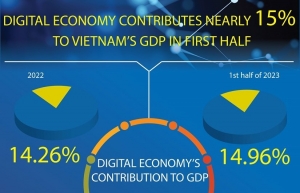Creative economy opens up new space for economic development
 |
| Creative economy opens up new space for economic development |
A recently launched report conducted by the Central Institute for Economic Management (CIEM) and in collaboration with the German International Cooperation Organization (GIZ) has highlighted some of the strengths, weaknesses, opportunities, and challenges for creative economic development in Vietnam.
Of these strengths are a rich and diverse cultural heritage; a young, dynamic and technologically proficient population; and positive policy changes supporting new economic models.
Weaknesses are inherent limitations in funding, especially in traditional creative sectors; lack of many skills related to the creative economy in many creative groups, especially middle-aged and elderly people, women, localities with difficult socioeconomic conditions; and inadequacies in "hard" and "soft" infrastructure for creative economic development.
“The report will continue to be completed to advise the government on solutions to promote growth through creative economic development, especially building a national strategy on the creative economy," said Tran Thi Hong Minh, president of CIEM.
The report noted that the main trend of creative economy over the world was exporting creative goods and services. The export of creative goods in the world increased from $208 billion in 2002 to $524 billion in 2020, of which, Asia has been the largest export region since 2007.
The structure of exported creative goods has changed significantly since 2006. Exports of CDs, DVDs, tapes, newspapers, and other printed materials decreased significantly, while exports of media and video game recordings increased sharply.
While developed countries dominate exports of visual and audiovisual arts, developing countries dominate exports of design and handicrafts.
Exports of creative services in the world have increased from $487 billion in 2010 to nearly $1.1 trillion in 2020. Exports of creative services have outstripped exports of creative goods due to the sharp increase in exporting software, research and development (R&D) services, and digitalisation of some innovative goods.
Developed countries are stronger in exporting innovative services than developing countries, but the gap between these two groups of countries is gradually narrowing.
Head of the CIEM’s General Research Department Nguyen Anh Duong said that numerous new production industries in the creative industry's supply chain have formed and developed strongly in fashion/textiles, microelectronics, and IT.
A diverse economy with strong growth in tourism, high-level manufacturing, and some knowledge industries also creates better conditions for the creative industry in Vietnam to develop.
“However, with a low starting point, Vietnam needs to learn from the experiences of many countries, as most of them are paying a lot of attention to creative economics,” Duong said.
For example, in the 13th five-year plan (2016-2020), China considered the creative economy as a new industry, in addition to IT, biotechnology, and low-carbon technology, accounting for 15 per cent of GDP in 2020.
In South Korea, the creative economy has been set as a major agenda and policy since 2013. According to this country’s government, the creative economy is a new economic strategy, creating new industries and markets by integrating and adjusting imagination and creativity into science, information and communication technology, creating sustainable jobs, and strengthening traditional industries.
In Indonesia, a country similar to Vietnam, the creative economy contributed $82 billion to this country's GDP (accounting for 7.5 per cent), and $23.9 billion for exports (about 10 per cent) in 2021, using about 19 million employees.
Indonesia has established a specialised ministry and agency to manage the creative economy called the Ministry of Tourism and Creative Economy, as well as built a relatively complete legal system regarding creative industries, including the Industrial Design Law; Trademark Law, Copyright Law, and National Industrial Policy.
In the United States, 4.01 per cent of all businesses and 2.04 per cent of workers were engaged in various creative industry sectors. Arts and culture accounted for 4.4 per cent of GDP, equivalent to $1.02 trillion in 2021.
To support workers and businesses in the creative industries, the US government issued the Promotion of Local Arts and Creative Economy Act. This aims to increase federal resources and expand federal benefits to those who use their creativity and skills on the job, empower creative workers, spur growth in new and existing businesses, and promote the export of American culture abroad. The US has also established an interdisciplinary council to encourage the development of a creative economy.
Singapore has issued strategies to promote a top-down creative economy with the directions of the government and the coordination of agencies. This country develops the measurement system of a creative economy by promoting statistics, as well as building a master plan to coordinate and implement policies and strategies.
 | Indonesia targets creating 4.4 million jobs in creative economy sector Indonesian Tourism and Creative Economy Minister Sandiaga Uno has targeted the creative economy sector to absorb 4.4 million domestic workers by 2024. |
 | Localities go creative in digital tourism Accelerating digitalisation is a solution for tourism businesses to reduce operating costs and open up opportunities to improve visitor experiences. |
 | Vietnam has three cities in UNESCO Creative Cities Network Two additional cities in Vietnam have been designated recently as UNESCO Creative Cities - Da Lat in the Central Highlands’ province of Lam Dong in term of music and Hoi An ancient town in the central province of Quang Nam in crafts and folk art. Vietnam now has three cities in the UNESCO Creative Cities Network (UCCN). |
 | Digital economy contributes 15 per cent to GDP in H1 Vietnam’s digital economy has played an important role in the country’s socio-economic development in recent times, and accounted for nearly 15 per cent of GDP in the first half of this year, according to the Ministry of Information and Communications. |
 | Promoting blockchain application in the digital economy Blockchain technology will not be able to create breakthrough growth and contribute strongly to Vietnam’s digital economy without a full legal corridor. The message was given at the Application of Blockchain Technology in the Digital Economy conference on September 27. |
 | Vietnam embracing digital economy From 2024, Vietnam will officially measure the added value proportion of the digital economy on the country’s GDP. Nguyen Thi Huong, director general of General Statistics Office (GSO) under the Ministry of Planning and Investment, spoke with VIR's Manh Bon about the country's current digital economy. |
What the stars mean:
★ Poor ★ ★ Promising ★★★ Good ★★★★ Very good ★★★★★ Exceptional
 Tag:
Tag:
Related Contents
Latest News
More News
- Businesses ramp up production as year-end orders surge (December 30, 2025 | 10:05)
- Vietjet chairwoman awarded Labour Hero title (December 29, 2025 | 13:06)
- How to unlock ESG value through green innovation (December 29, 2025 | 10:03)
- AI reshapes media and advertising industry (December 29, 2025 | 08:33)
- FPT and GELEX sign deal to develop blockchain tech for global markets (December 29, 2025 | 08:29)
- Vietnam’s GDP forecast to grow by 9 per cent in 2026 (December 29, 2025 | 08:29)
- Women entrepreneurs are key to Vietnam’s economic growth (December 29, 2025 | 08:00)
- Vietnam's top 500 value-creating enterprises announced (December 27, 2025 | 08:00)
- The PAN Group shaping a better future with ESG strategy (December 26, 2025 | 09:00)
- Masan Consumer officially lists on HSX, marking the next phase of value creation (December 25, 2025 | 13:20)





























 Mobile Version
Mobile Version